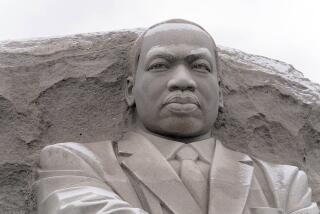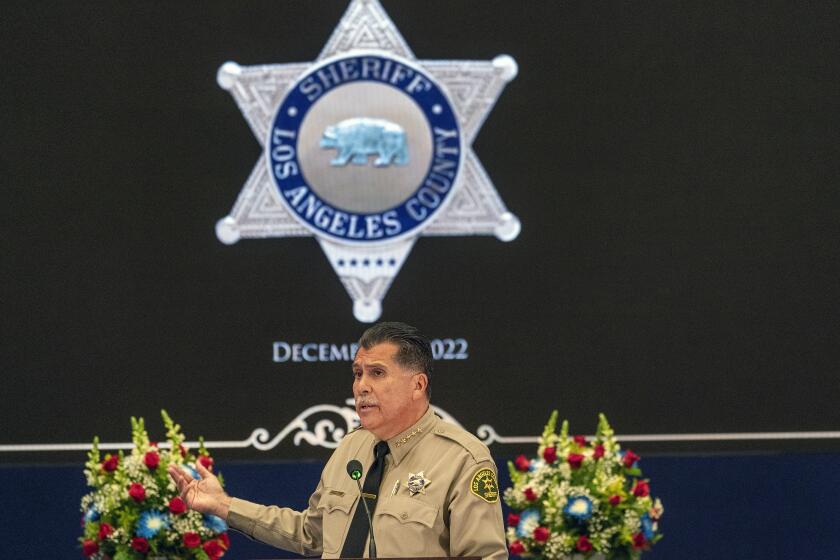A lull in the war on Christmas
IT JUST DOESN’T seem like Christmas this year — because there have been so few stories in the media about how the holiday is under siege by secular progressives. Some irony-deficient Chicago officials refused to allow advertising for “The Nativity Story” at the city’s annual Christkindlmarket, an open-air re-creation of a European village. And Seattle-Tacoma International Airport’s staff removed — then replaced — more than a dozen Christmas trees after a rabbi threatened to sue if a menorah wasn’t included in the display. But, by and large, it’s been a quiet season.
The Christmas wars were inescapable in 2005. The American Family Assn., a pro-family Christian group, led a boycott of Target because of its reputed refusal to use the word “Christmas” in its advertising and store promotions. Other Christian organizations criticized Macy’s and Wal-Mart for favoring the generic “Happy Holidays” greeting over “Merry Christmas.” (This year, the retailers returned to Christmas-specific language in their sales signs and promotions.) Fox News, CNN and MSNBC aired numerous stories about secularist grinches.
The salvos between politically correct busybodies and pious protesters in 2004 were equally intense. Denver prohibited a church group from participating in its annual Parade of Lights because it wanted to sing Christmas songs; a New Jersey high school barred its band from playing religious-themed Christmas music; a Kansas newspaper published a correction apologizing for calling a Community Tree a Christmas Tree; and a priest got in trouble for telling kindergartners that Jesus — not Santa — was the reason for Christmas.
But the war on Christmas didn’t start in 2004 either. In fact, it’s been ebbing and flowing for centuries wherever Christianity is practiced — and especially in the United States. Debating how — or even whether — to celebrate Christmas seems to be one of Americans’ favorite pastimes.
Although commonly perceived as a secular versus religious debate, the earliest Christmas wars were interdenominational battles. Some Protestants rejected holy days such as Christmas because they were not explicitly mentioned in Scripture, while Anglicans, Lutherans and Roman Catholics retained the liturgical calendar. By the time secularists targeted Christmas in the 20th century, the interdenominational battles were over, and virtually all Christians adopted Christmas as a holy day.
From the beginning, Mayflower Pilgrims didn’t mark Christmas, considering it “diabolical” because its celebration was encouraged by their enemy, the pope. The Puritans’ political influence was so strong in Massachusetts that the commonwealth banned the holiday’s observance until 1681. Meanwhile, Roman Catholics in Maryland, Anglicans in Virginia and Lutherans in Pennsylvania celebrated Christmas.
Interdenominational disagreements and language barriers prevented the development of any broad consensus on how to celebrate the holiday. But in the early 19th century, businessmen and religious leaders began calling for a wider and more public observance of Christmas. Quakers, Congregationalists and Calvinists still balked at marking the day because of its commercialism and revelry. But acceptance of the holiday haltingly grew. By 1860, 16 of 33 states legally recognized Christmas. It took another 10 years before Congress made it a federal holiday.
But the debate over how much religious content should be in the celebration of Christmas continued. Liturgical Christians regarded the day as sacred because they believed it marked God’s incarnation in Jesus. But the Baptist Teacher, a Sunday school periodical, editorialized in 1875: “We believe in Christmas — not as a holy day but as a holiday . Stripped as it ought to be, of all pretensions of religious sanctity and simply regarded as a social and domestic institution.” Ironically, modern-day Baptists would excoriate any newspaper that published such an editorial.
The emergence of Santa Claus as central to Christmas in the 19th century caused great consternation among many religious Americans. “This Santa Claus folly has infected family life, literature, church services, everything almost, at this season,” wrote one Lutheran critic in 1883. That same year, however, George William Curtis, a founder of the Republican Party and political editor of Harper’s Weekly, published a piece thanking the Puritans for stripping Christmas of its theological foundations. Christmas “could not be the most beautiful of festivals if it were doctrinal, or dogmatic, or theological, or local,” he wrote.
In the early 20th century, New York City’s Committee on Elementary Schools urged that Christmas carols be banned in classrooms after 20,000 Jewish students boycotted classes in protest. Some movies in the 1940s, including “Miracle on 34th Street” and “It’s a Wonderful Life,” introduced a nonreligious iconography that secular and religious Americans could unite behind. In the late 1950s, the John Birch Society issued tracts accusing godless communists of waging war on Christmas.
Before the fighting picked up again in 2004, school administrators, fearful of lawsuits, banned every Bach cantata sung at a public school in 2001, and secularists began winning battles in court against the exclusive display of creches in the public square. Pro-Christmas forces responded with “Jesus Is the Reason for the Season” and “Put Christ Back in Christmas” rallying cries, leading us to where we are today.
The relative absence of yuletide battles this year hardly means a truce has been declared. Judging by history, they will soon return to let us know it’s the season.
More to Read
Start your day right
Sign up for Essential California for news, features and recommendations from the L.A. Times and beyond in your inbox six days a week.
You may occasionally receive promotional content from the Los Angeles Times.






